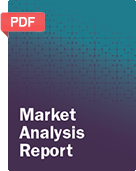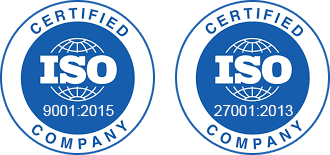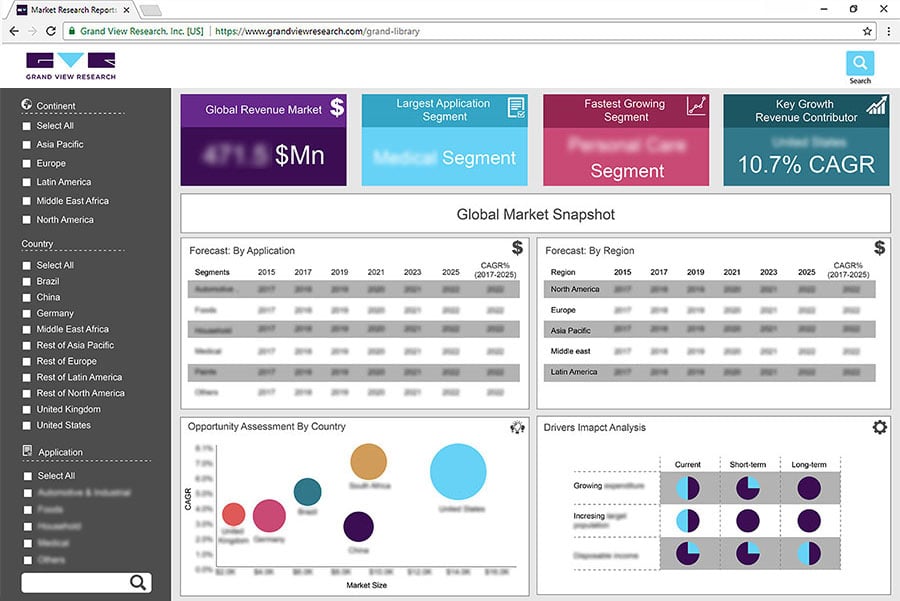
Polyolefin Market Size, Share & Trends Analysis Report By Product (Polyethylene, Polypropylene, Polycarbonate), By Application (Film & Sheet, Injection Molding, Blow Molding), By Region, And Segment Forecasts, 2023 - 2033
- Report ID: GVR-2-68038-091-0
- Number of Pages: 129
- Format: Electronic (PDF)
- Historical Range: 2018 - 2021
- Industry: Bulk Chemicals
Research Methodology
A three-pronged approach was followed for deducing the polyolefin market estimates and forecasts. The process has three steps: information procurement, analysis, and validation. The whole process is cyclical, and steps repeat until the estimates are validated. The three steps are explained in detail below:
Information procurement: Information procurement is one of the most extensive and important stages in our research process, and quality data is critical for accurate analysis. We followed a multi-channel data collection process for polyolefin market to gather the most reliable and current information possible.
- We buy access to paid databases such as Hoover’s and Factiva for company financials, industry information, white papers, industry journals, SME journals, and more.
- We tap into Grand View’s proprietary database of data points and insights from active and archived monitoring and reporting.
- We conduct primary research with industry experts through questionnaires and one-on-one phone interviews.
- We pull from reliable secondary sources such as white papers and government statistics, published by organizations like WHO, NGOs, World Bank, etc., Key Opinion Leaders (KoL) publications, company filings, investor documents, and more.
- We purchase and review investor analyst reports, broker reports, academic commentary, government quotes, and wealth management publications for insightful third-party perspectives.
Analysis: We mine the data collected to establish baselines for forecasting, identify trends and opportunities, gain insight into consumer demographics and drivers, and so much more. We utilized different methods of polyolefin market data depending on the type of information we’re trying to uncover in our research.
-
Market Research Efforts: Bottom-up Approach for estimating and forecasting demand size and opportunity, top-down Approach for new product forecasting and penetration, and combined approach of both Bottom-up and Top-down for full coverage analysis.
-
Value-Chain-Based Sizing & Forecasting: Supply-side estimates for understanding potential revenue through competitive benchmarking, forecasting, and penetration modeling.
-
Demand-side estimates for identifying parent and ancillary markets, segment modeling, and heuristic forecasting.
-
Qualitative Functional Deployment (QFD) Modelling for market share assessment.
Market formulation and validation: We mine the data collected to establish baselines for forecasting, identify trends and opportunities, gain insight into consumer demographics and drivers, and so much more. We utilize different methods of data analysis depending on the type of information we’re trying to uncover in our research.
-
Market Formulation: This step involves the finalization of market numbers. This step on an internal level is designed to manage outputs from the Data Analysis step.
-
Data Normalization: The final market estimates and forecasts are then aligned and sent to industry experts, in-panel quality control managers for validation.
-
This step also entails the finalization of the report scope and data representation pattern.
-
Validation: The process entails multiple levels of validation. All these steps run in parallel, and the study is forwarded for publishing only if all three levels render validated results.
Polyolefin Market Categorization:
The polyolefin market was categorized into three segments, namely product (Polyethylene, Polypropylene, Ethylene-Vinyl Acetate, Thermoplastic Polyolefins, Polyoxymethylene, Polycarbonate, Polymethyl Methacrylate), application (Film & Sheet, Injection Molding, Blow Molding, Profile Extrusion), and regions (North America, Europe, Asia Pacific, Central & South America, Middle East & Africa).
Segment Market Methodology:
The polyolefin market was segmented into product, application, and regions. The demand at a segment level was deduced using a funnel method. Concepts like the TAM, SAM, SOM, etc., were put into practice to understand the demand. We at GVR deploy three methods to deduce market estimates and determine forecasts. These methods are explained below:
Market research approaches: Bottom-up
-
Demand estimation of each product across countries/regions summed up to from the total market.
-
Variable analysis for demand forecast.
-
Demand estimation via analyzing paid database, and company financials either via annual reports or paid database.
-
Primary interviews for data revalidation and insight collection.
Market research approaches: Top-down
-
Used extensively for new product forecasting or analyzing penetration levels.
-
Tool used invoice product flow and penetration models Use of regression multi-variant analysis for forecasting Involves extensive use of paid and public databases.
-
Primary interviews and vendor-based primary research for variable impact analysis.
Market research approaches: Combined
- This is the most common method. We apply concepts from both the top-down and bottom-up approaches to arrive at a viable conclusion.
Regional Market Methodology:
The polyolefin market was analyzed at a regional level. The global was divided into North America, Europe, Asia Pacific, Central & South America, and Middle East & Africa, keeping in focus variables like consumption patterns, export-import regulations, consumer expectations, etc. These regions were further divided into seventeen countries, namely, the U.S.; Canada; Mexico; Germany; the UK.; Italy; France; Spain; China; India; Japan; South Korea; Australia; Brazil; Argentina; South Africa; Saudi Arabia.
All three above-mentioned market research methodologies were applied to arrive at regional-level conclusions. The regions were then summed up to form the global market.
Polyolefin market companies & financials:
The polyolefin market was analyzed via companies operating in the sector. Analyzing these companies and cross-referencing them to the demand equation helped us validate our assumptions and conclusions. Key market players analyzed include:
-
China Petrochemical Corporation - China Petrochemical Corporation is a prominent player in the polyolefin industry, with a strong presence across various sectors within the energy domain. Its operations comprise oil and natural gas exploration, production, refining, as well as manufacturing and distribution of petrochemicals and chemical goods. The company is committed to research and development, driving innovation in energy technologies, promoting environmental preservation, and ensuring a steady provision of energy resources to cater to global and local market demands.
-
LyondellBasell Industries Holdings B.V. - LyondellBasell Industries Holdings B.V. is a major player in the chemicals and plastics industry, operating across various key verticals. The company is one of the global leaders in the production and refining of essential materials such as ethylene, propylene, and other polyolefins, which are used in a wide range of everyday products. Additionally, the company is also involved in developing advanced polymers, resins, and chemicals that contribute to innovations in packaging, automotive components, construction materials, and more. Moreover, the company is also focused on recycling and eco-friendly solutions, reflecting its integral role in shaping the modern world of materials and manufacturing.
-
PetroChina Company Limited - PetroChina Company Limited operates across multiple integral verticals within the energy sector. It is one of China's largest and most prominent energy companies and is engaged in the exploration, production, and distribution of oil and natural gas, both domestically and internationally. The company also plays a significant role in refining crude oil into various petroleum products, and it is actively involved in petrochemical production, comprising a wide range of chemicals and materials for industries such as plastics, textiles, and agriculture. The company’s commitment to research and technological advancements ensures a consistent and sustainable supply of energy resources while contributing to the overall growth and development of the global energy landscape.
-
TotalEnergies - TotalEnergies is one of the leading integrated energy companies that operate across exploration and production, refining, renewable energy, and petrochemical sectors. The upstream activities of the company encompass the exploration and extraction of both, conventional and unconventional oil and natural gas resources across the globe. In the downstream segment, the company refines these hydrocarbons to produce a wide range of petroleum products. Moreover, the company focuses on strengthening its foothold in the renewable energy sector by investing in solar, wind, and other sustainable energy sources.
-
Chevron Corporation - Repsol is engaged in both upstream and downstream segments. In the upstream segment, the company explores and produces hydrocarbon resources from conventional and unconventional reserves. In the downstream segment, the company is involved in refining crude oil to produce a wide range of refined products that cater to various industries. Moreover, the company is committed to sustainability by investing in renewable energy sources, including wind and solar power. The company also extends its reach to petrochemicals, manufacturing essential chemicals used in numerous applications. With its multifaceted presence, technological advancements, and commitment to a sustainable energy future, the company holds its prominent position in the energy sector.
-
Repsol - Repsol is engaged in both upstream and downstream segments. In the upstream segment, the company explores and produces hydrocarbon resources from conventional and unconventional reserves. In the downstream segment, the company is involved in refining crude oil to produce a wide range of refined products that cater to various industries. Moreover, the company is committed to sustainability by investing in renewable energy sources, including wind and solar power. The company also extends its reach to petrochemicals, manufacturing essential chemicals used in numerous applications. With its multifaceted presence, technological advancements, and commitment to a sustainable energy future, the company holds its prominent position in the energy sector.
-
Dow - Dow has segmented its operations into five segments including agriculture sciences, consumer solutions, infrastructure solutions, performance materials & chemicals, and performance plastics. The performance materials and chemicals segment includes products such as chloralkali and vinyl, chlorinated organic, epoxy, industrial solutions, and polyurethanes. The company caters its products to various end-use industries including agriculture, automotive, building & construction, consumer, energy & water, electronic materials, infrastructure, packaging, and product safety.
-
Exxon Mobil Corporation - Exxon Mobil Corporation has five business divisions, namely, upstream, chemical, downstream, and natural gas and power marketing. The chemical division of the company includes plastics, rubber, plasticizers, acids, additives, and solvents & fluids. The division caters to end-use industries including automotive, construction, lubricants, medical & healthcare, oil & gas, consumer goods, utility, and packaging.
-
Braskem - Braskem operates across essential operating verticals within the petrochemical sector. The company is one of the significant players in the production of petrochemicals, manufacturing a diverse range of chemical and plastic products that cater to a wide range of industries. Its verticals encompass the production of basic petrochemicals such as ethylene and propylene, as well as the development of more complex polymers and resins used in packaging, automotive components, and construction materials.
-
Borealis AG - Borealis AG is one of the leading producers of innovative polyolefins, base chemicals, and fertilizers, playing a crucial role in supplying materials for various applications. The company’s verticals encompass the manufacturing of polyethylene and polypropylene, essential in producing a wide range of everyday products, from packaging to automotive components.
Value chain-based sizing & forecasting
Supply Side Estimates
-
Company revenue estimation via referring to annual reports, investor presentations, and Hoover’s.
-
Segment revenue determination via variable analysis and penetration modeling.
-
Competitive benchmarking to identify market leaders and their collective revenue shares.
-
Forecasting via analyzing commercialization rates, pipelines, market initiatives, distribution networks, etc.
Demand side estimates
-
Identifying parent markets and ancillary markets
-
Segment penetration analysis to obtain pertinent
-
revenue/volume
-
Heuristic forecasting with the help of subject matter experts
-
Forecasting via variable analysis
Polyolefin Market Report Objectives:
-
Understanding market dynamics (in terms of drivers, restraints, & opportunities) in the countries.
-
Understanding trends & variables in the individual countries & their impact on growth and using analytical tools to provide high-level insights into the market dynamics and the associated growth pattern.
-
Understanding market estimates and forecasts (with the base year as 2022, historic information from 2018 to 2021, and forecast from 2023 to 2030). Regional estimates & forecasts for each category are available and are summed up to form the global market estimates.
Polyolefin Market Report Assumptions:
-
The report provides market value for the base year 2022 and a yearly forecast till 2030 in terms of revenue/volume or both. The market for each of the segment outlooks has been provided on region & country basis for the above-mentioned forecast period.
-
The key industry dynamics, major technological trends, and application markets are evaluated to understand their impact on the demand for the forecast period. The growth rates were estimated using correlation, regression, and time-series analysis.
-
We have used the bottom-up approach for market sizing, analyzing key regional markets, dynamics, & trends for various products and end-users. The total market has been estimated by integrating the country markets.
-
All market estimates and forecasts have been validated through primary interviews with the key industry participants.
-
Inflation has not been accounted for to estimate and forecast the market.
-
Numbers may not add up due to rounding off.
-
Europe consists of EU-8, Central & Eastern Europe, along with the Commonwealth of Independent States (CIS).
-
Asia Pacific includes South Asia, East Asia, Southeast Asia, and Oceania (Australia & New Zealand).
-
Latin America includes Central American countries and the South American continent
-
Middle East includes Western Asia (as assigned by the UN Statistics Division) and the African continent.
Primary Research
GVR strives to procure the latest and unique information for reports directly from industry experts, which gives it a competitive edge. Quality is of utmost importance to us, therefore every year we focus on increasing our experts’ panel. Primary interviews are one of the critical steps in identifying recent market trends and scenarios. This process enables us to justify and validate our market estimates and forecasts to our clients. With more than 8,000 reports in our database, we have connected with some key opinion leaders across various domains, including healthcare, technology, consumer goods, and the chemical sector. Our process starts with identifying the right platform for a particular type of report, i.e., emails, LinkedIn, seminars, or telephonic conversation, as every report is unique and requires a differentiated approach.
We send out questionnaires to different experts from various regions/ countries, which is dependent on the following factors:
-
Report/Market scope: If the market study is global, we send questionnaires to industry experts across various regions, including North America, Europe, Asia Pacific, Latin America, and MEA.
-
Market Penetration: If the market is driven by technological advancements, population density, disease prevalence, or other factors, we identify experts and send out questionnaires based on region or country dominance.
The time to start receiving responses from industry experts varies based on how niche or well-penetrated the market is. Our reports include a detailed chapter on the KoL opinion section, which helps our clients understand the perspective of experts already in the market space.



